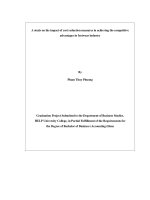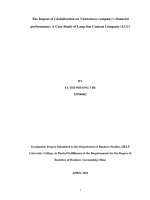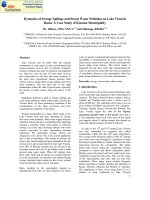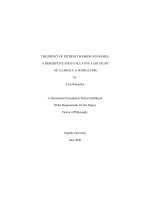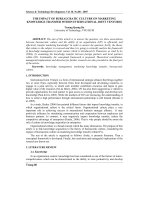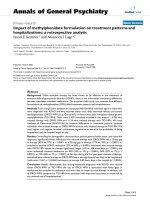impact of globalization on international accouting harmonization a case of vietnam
Bạn đang xem bản rút gọn của tài liệu. Xem và tải ngay bản đầy đủ của tài liệu tại đây (677.04 KB, 114 trang )
IMPACT OF GLOBALIZATION ON INTERNATIONAL ACCOUTING
HARMONIZATION: A CASE OF VIETNAM
BY
NGUYEN THI PHUONG THAO
Graduation Project Submitted to the Department of Business Studies
Help University College, in Partial Fulfillment of Requirements for
The Degree of Bachelor of Business (Accounting) Hons
JUNE 2010
ACKNOWLEDGEMENT
First and foremost, my sincere gratitude is dedicated to my supervisor – Dr. Le Van
Lien. Thanks for your strong support, guidance, intuitive comments, and also
motivation through the process of completing this thesis.
In addition, I would like to send my gratitude to the International School and HELP
University College for giving me an opportunity to conduct my study in my favorite
area.
Furthermore, I also address my appreciation to Mr. Nguyen Xuan Thuy (Vice chief
Executive of Bao Viet finance- insurance Groups) and Ms. Ho Thi Thu Phuong
(Academic Administrator of British University Vietnam) who supported my thesis
with enormous information in data collection process. My thankfulness is also
addressed to others who have helped me since the beginning of my study until I can
finish my thesis.
Finally, thanks you to all my family and friends, for your support, help, and
motivation and made it possible for me to complete this study.
Hanoi, June 2010
Nguyen Thi Phuong Thao
IMPACT OF GLOBALIZATION ON INTERNATIONAL ACCOUTING
HARMONIZATION: A CASE OF VIETNAM
BY
NGUYEN THI PHUONG THAO
JUNE 2010
Supervisor: Dr. Le Van Lien
ABSTRACT
This study provides the framework for understanding the concept of accounting
harmonization. Some of key elements relating to this concept such as: the importance
of accounting harmonization in global economy, the actor of issuance IAS, the
advantages and disadvantages of accounting harmonization, the different levels of
accounting harmonization are clarified. This study also tries to evaluate the
infrastructure of accounting system in Vietnam response to international accounting.
First of this action, the researcher evaluate the role of MOF in its efforts for making
harmonization process. This is shown by establishment of Vietnamese accounting
standards. Secondly, the researcher tries to compare some typical Vietnamese
Accounting Standards and International Accounting Standards. The purpose of
comparison is to evaluate the adoption of international accounting into Vietnamese
accounting environment. Furthermore, the researcher desires to examine the
awareness of Vietnamese accountants (including different levels) toward accounting
harmonization. This research tries to evaluate how their attitudes, their behaviors,
and their needs relating to accounting harmonization. Finally, this study tries to
evaluate actual applications and accounting treatments in some companies (different
types and sizes of companies) in accordance with accounting harmonization. This is
because once we understand and evaluate the actual picture of accounting
harmonization process in Vietnam, we can learn from the experience. This is helpful
for future research or strategic plans. From the results obtained through
questionnaires, the term of accounting harmonization is not new in Vietnam, and
Vietnam is completing its harmonization process step by step. However, awareness
of Vietnamese about this term is different from each other, and the differences
between actual applications in some companies. Thus, several recommendations and
scopes for future research might be developed by the researcher. However, because
of limitation, this study only covers some typical items of this topic.
TABLE OF CONTENT
Page
Declaration of Originality and Word Count
ii
Acknowledgment
iii
Abstract
iv
Table of content
vi
List of tables
ix
List of Abbreviations
xi
CHAPTER 1
INTRODUCTION
1.1 Background of the study
1
1.2 Research objectives
2
1.3 Problem statement
4
1.4 Limitation of the study
5
1.5 Organization of the research
6
References
7
CHAPTER 2
LITERATURE REVIEW
2.1 The importance of accounting harmonization
8
2.1.1 The need for accounting harmonization
8
2.1.2 Distinguish between accounting harmonization and accounting
standardization
9
2.2 The actor of issuance IAS
10
2.3 Advantages of accounting harmonization
11
2.4 Disadvantages of accounting harmonization
13
2.5 Different levels of accounting harmonization
14
2.5.1 International level of accounting harmonization
14
2.5.2 Regional level of accounting harmonization
15
2.5.3 National level of accounting harmonization
17
2.5.3.1 Some countries in ASEAN
17
2.5.3.2 Vietnam
19
References
21
CHAPTER 3
RESEARCH METHODOLOGY
3.1 Research objectives
27
3.2 Research Methodology
28
3.2.1 Primary data
28
3.2.2 Secondary data
29
3.3 Research Instrument
30
3.3.1 Awareness of Vietnamese accountants of accounting harmonization
31
3.3.2 How companies in Vietnam response to accounting harmonization
31
3.4 Research Hypotheses
32
3.5 Data Collection
33
3.6 Sampling
34
3.6.1 Firms
34
3.6.2 Accountants
34
3.7 Response Rate
34
3.8 Interpretation of Data
35
3.9 Limitation of Research
35
References
36
CHAPTER 4 ANALYSIS OF DATA
4.1 Vietnamese accounting standards (VAS) responding
37
4.1.1 General overview
37
4.1.2 The actors
38
4.1.3 Evaluation the role of MOF in process of establishment VAS
38
4.1.4 Vietnamese accounting standards
39
4.2 Comparison between some typical VAS and IAS
41
4.2.1 VAS 02 and IAS 02
41
4.2.2 VAS 24 and IAS 07
42
4.2.3 VAS 25 and IAS 27
42
4.3 Analysis of primary data
43
4.3.1 Classification of the respondents of different job levels
43
4.3.2 Classification of the Respondents from Types of Companies
44
4.3.3 Test hypotheses
45
4.4.3.1 Awareness of Vietnamese Accountants
45
4.4.3.2 Practice of accounting treatments in some companies in
Vietnam responding to accounting harmonization
54
References
64
CHAPTER 5 CONCLUSION
5.1 Comparison between IAS and VAS
66
5.2 Awareness of Vietnamese accountants relating to accounting
harmonization
67
5.3 Accounting treatments in some companies in Vietnam
68
5.4 Recommendation
70
5.5 Scope for future research
71
BIBILIOGRAPHY
73
APPENDICES
81
LIST OF TABLES
Tables
Title
Page
Table 4-1
Four VAS issued and promulgated in 2001 and relating IAS
39
Table 4-2
Six VAS issued and promulgated in 2002 and relating IAS
39
Table 4-3
Six VAS issued and promulgated in 2003 and relating IAS
40
Table 4-4
Six VAS issued and promulgated in 2004 and relating IAS
40
Table 4-5
Four VAS issued and promulgated in 2005 and relating IAS
40
Table 4-6
Comparison between VAS 02 and IAS 02
41
Table 4-7
Comparison between VAS 24 and IAS 07
42
Table 4-8
Comparison between VAS 25 and IAS 27
43
Table 4-9
Classification of the respondents of Different job level
44
Table 4-10
Classification of the Respondents from Types of Companies
44
Table 4-11
Hear the term of “accounting harmonization”
46
Table 4-12
Perception of the training program for accountant to
improve their knowledge relating to international
accounting
47
Table 4-13
Perception of translating financial statements into English
48
Table 4-14
Accounting harmonization is the essential tool to develop in
global economy
50
Table 4-15
Accounting harmonization can reduce the gap amongst
different accounting systems in each country
51
Table 4-16
Accounting harmonization can take easy ability to adapt
than accounting standardization
52
Table 4-17
Accounting harmonization can encourage more global
economic activities
53
Table 4-18
Have a person can work with international accounting
standards
55
Table 4-19
Preparation cash flow statement per annual
56
Table 4-20
Having financial statements translated into English
57
Table 4-21
Duration companies have applied VAS in preparation
financial statements
58
Table 4-22
Preparation financial statements
59
Table 4-23
Application of VAS in accounting system
60
Table 4-24
Recruitment employees can prepare and understand the
financial statements in English
62
Table 4-25
Translating financial statements into English
63
LIST OF ABBREVIATIONS
Abbreviation
Full Name
AFA
ASEAN Federation of Accountants
ASC
Accounting Standards Council
ASEAN
Association of South East Asian nations
ASPC
Auditing Standards and Practices Council
BOA
Board of Accountancy
EFRAG
European Financial Reporting Advisory Group
EU
European Union
FEE
Federation des Experts Comptables Europeens
IAI
Indonesian Institute of Accountants
IAS
International Accounting Standards
IASB
International Accounting Standards Board
ICAAT
Institute of Certified Accountants and Auditors of Thailand
ICAEW
Institute of Charted Accountants of England and Wales
ICPAS
Institute of Certified Public Accountants of Singapore
IFAC
International Federation of Accountants
IFRS
International Financial Reporting Standard
ISAR
International Standard of Accounting and Reporting
MOF
Ministry of Finance
OECD
Organization for Economic Co-operation and Development
PICPA
Philippine Institute of Certified Public Accountants
VAS
Vietnam accounting standards
WTO
World Trade Organization
CHAPTER 1
INTRODUCTION
1.1 BACKGROUND OF THE STUDY
In recent time, we often hear the term of “globalization”. This concept is becoming
the new trend all over the world. What is globalization? Generally, globalization is
the worldwide integration of some typical aspects (economy, technology, politic,
culture, and society) across countries to improve the collaboration amongst various
countries, and help each other on development (Sara Hamilton, 2009). In other
words, globalization leads to the in-depth influence on various aspects of modern
society. Often, when we call the term of “globalization”, we often imply the
economic globalization. As we known, accounting is the basic tool, as well as the
basic language to improve economic developments. Therefore, globalization raise the
big question: What is the most difficulty amongst typical accounting systems across
countries? Under the effect of globalization, accounting harmonization becomes a
big issue in worldwide picture. That’s why, accounting harmonization considered as
the main topic on current and heated discussion (Keegan, 1988).
Perception on accounting harmonization in rests of the world changes significantly
since more and more countries set up their accounting standards. Those standards
provide guidelines about application accounting system respond to international
accounting standards issued by the International Accounting Standards Board
(IASB). For examples: according to Jeffrey (1999) one of the top priorities of
Instituto Mexicao de Contadores Publicos (IMCP) of Mexico is to make
harmonization with International Accounting Standards (IAS); some other countries
such as Australia and countries in the European Union also have elected to adopt the
accounting standards issued by the IASB (Craig Deegan, 2009). In South East Asia,
some similar situations relating to making accounting harmonization are also
concerned. The Association of South East Asian nations (ASEAN) play the
important role to improve the economy amongst the countries of South East Asia.
This organization makes significant efforts for accounting harmonization through
ASEAN countries. This purpose is expressed through Federation of Accountants
(AFA). ASEAN tries to provide the guidelines and techniques to its members’
professional accounting bodies about application of IAS effectively. As compared to
other countries, Vietnam takes significant steps to respond the impact of
globalization on accounting harmonization. Through this study, the researcher
attempts to provide the detailed information relating to accounting harmonization in
global economy and how Vietnam to respond this issue.
1.2 RESEARCH OBJECTIVES
This study is developed to explore the impact of how Vietnam response to
accounting harmonization in global economy. Accordingly, there are several
objectives discussed in this study:
First of all, the main objective is to provide all necessary information relating to the
accounting harmonization. The question: “Why do we need to make accounting
harmonization in global economy?” will be discussed. According to this study, the
researcher provides the general introduction of IASB and the role of IASB in making
accounting harmonization process of issuance IAS. Some advantages and
disadvantages of various countries of application IAS in international accounting
environment are also mentioned. In order to help readers understand about the topic,
accounting harmonization will be divided in to three levels including international
level, regional level, and national level (gupea.ub.gu.se). The first level (international
level) will support for the overview of accounting harmonization from the world’s
perspective. The next level (regional level) will provide some detailed information
relating to methods that typical regions response to accounting harmonization. At the
last level (national level), we discuss some significant efforts of each country to
reach the accounting harmonization.
The second objective is to clarify impact of “reform process” in 1986 on accounting
environment in Vietnam. That year is considered as the important point of economic
development in Vietnam. Vietnam carried out a reform process of changing its
centrally planned economy to a socialist market-oriented economy, liberalizing the
domestic economy and integrating with outside the world (dissertations.ub.rug.nl).
The “reform process” also encourages the initial step to establish Vietnamese
Accounting Standards (VAS) in accordance with accounting harmonization. In
addition, VAS and process of issuance of VAS are discussed. Moreover, the
researcher tries to compare some typical IAS and VAS.
The third objective is obtained from the view of accountants in finance and
accounting department of some companies in Vietnam. The researcher tried to design
ten questions to explore their awareness about international accounting, and making
Vietnam accounting policy harmonization with international accounting.
Furthermore, by conducting the research, the researcher intends to discuss more
factors causing impacts on application international accounting in Vietnam in
practice rather than collecting from the available sources. Some research hypotheses
are also will be developed and tested through the process of conducting research
using chi-square test. The researcher tries to provide the completed view about the
application international accounting in Vietnam through Vietnamese accountants’
awareness, and response of some companies in Vietnam to accounting
harmonization.
1.3 PROBLEM STATEMENT
Nowadays, since the wave of global economy increases rapidly, this requires to
establish a main set of accounting environment for all countries to application
referred to IAS/IFRS. This process brings important meaning importance because
accounting harmonization is the basic tool reducing the gap across national
accounting polices. The main benefit of this process for improvement economic
integration activities amongst various countries whether those countries come from
the different parts or regions of the world.
Moreover, discussion about accounting harmonization has the special meaning for
Vietnam, since Vietnam joined World Trade Organization (WTO) on 11 January
2007(wto.org). By joining WTO, Vietnam went to the large ocean; Vietnam accepted
the competitive environment and expanding economic activities outside country.
Thus, accounting policy in Vietnam needs to be approached with international
accounting near by near (news.bbc.co.uk).
Within this study, the researcher provides more about understanding the issues of
Vietnam toward international accounting through some questions as follows:
Does Vietnam change accounting policy toward international accounting?
Does Vietnam have some significant efforts to make accounting
harmonization in global economy?
Is it benefit for Vietnam to reach accounting harmonization?
Does Vietnam set up Vietnam accounting standards in harmonization (VAS)
with IAS/IFRS?
What is the process to make accounting harmonization taking place in
Vietnam?
Does Vietnam need more necessary conditions in harmonization process?
Answering these questions above will help to expand understanding of current
accounting policy in Vietnam and its efforts to pursuit accounting harmonization.
1.4 LIMITATION OF THE STUDY
This study is limited to discussion on some specific of relating accounting area such
as: accounting standards, financial reports, inventories, cash flows and so on. It is
hard to cover all items of the issue here because it includes a broad range.
Furthermore, the limitations of time also make the researcher not to conduct this
study on all aspects relating to issue. Therefore, the researcher needs to select some
specific item to clarify and discuss to help the reader understand in the effective way
about all the necessary information relating to the topic in general.
1.5 ORGANIZATION OF THE RESEARCH
This study will be organized into five chapters. This is because the readers can
understand this paper on the logical way. Five chapters referred here as: introduction,
literature review, research methodology, analysis, and conclusion.
Chapter 1, with the title “Introduction” will mention the general picture about the
relating topic.
Chapter 2, with the title “Literature review” will provide all necessary information
relating to accounting harmonization. Some key factors of accounting harmonization
are the importance of accounting harmonization, the role of IASB, advantages and
disadvantages of accounting harmonization, and different levels of accounting
harmonization.
Chapter 3, with the title “Research methodology” will describe the research tools,
and data sources in conducting this study like as: primary data, secondary data, and
so on.
Chapter 4, with the title “Analysis” will analyze all the collected information (from
both of secondary and primary data) of how Vietnam responses to accounting
harmonization.
Chapter 5, with the title “Conclusion” will sum up and evaluate all the results from
this study, simultaneously propose some useful suggestions for further studies
relating to this similar issue.
CHAPTER 2
LITERATURE REVIEW
This chapter is developed to provide framework relating to accounting
harmonization. The aim of this chapter is to help the readers understand various
aspects around this term of international accounting harmonization. Accordingly, the
readers can develop their background relating to this topic.
2.1 THE IMPORTANCE OF ACCOUNTING HARMONIZATION
Belongs to this section, we approach the justifications of accounting harmonization.
In order to help the readers obtain this topic in the effective way, this section will be
divided into two subsections. The purpose of doing that is to explain of the need for
accounting harmonization. Moreover, the readers can distinguish between accounting
harmonization and accounting standardization clearly.
2.1.1 The need for accounting harmonization
The global economy developing rapidly leads to significant effects on accounting
environment. One of those effects is the barrier amongst different accounting rules in
each country when integrating global activities. This is because accounting is
considered as the language of business (Ph. Diaconu PAUL). Obviously, if different
countries flow the same accounting rules, the gap between accounting system in each
country will disappear (Craig Deegan, 2009). This issue leads to the global efforts for
establishment a set of accounting standards applied by different countries.
Accordingly, international accounting standards will open new horizon of evolution
(Anderson, 1993). Those standards will help the different financial information
between various companies become more relevant in the purpose of comparative
analyses or comparisons.
2.1.2 Distinguish between accounting harmonization and accounting
standardization.
In recent years, people always talk about international accounting. However, most of
them still confuse between accounting standardization and accounting
harmonization. Before understanding relating aspects of international accounting
harmonization, the readers need to know the basic feature of each concept.
The first concept known as accounting standardization referred to a more rigid and
narrow set of rules (Nobes and Parker, 2004). The implication under this term is
different countries need to follow the unique set of accounting rules, fundamental
principles, accounting standards without amendment and making adoption with
regulations in each country. The main advantage of using accounting standardization
is to use the consistent accounting systems amongst different countries, save time
and transfer cost. However, this also causes the main challenge for countries with
lower infrastructure of accounting policy than others.
The second concept is known as accounting harmonization. This concept includes
the similar characteristic with accounting standardization. However, accounting
harmonization is more flexible in which allows every country to establish its
accounting standards to meet its regulation based on international accounting
standards. As far as concern, accounting harmonization has to develop from the base
of accounting standardization (Weber, Cameron M., 1992) because we need the
framework of accounting standards first, and then different countries make
amendment for harmonization with international accounting standards. Based on this
fundamental advantage mentioned above, accounting harmonization is preferred by
most countries. The actor of issuance of international accounting standards, the
advantages and disadvantages of this concept, as well as the different level of
accounting harmonization will be discussed later.
2.2 THE ACTOR OF ISSUANCE IAS
International Accounting Standards Board (IASB) is considered as the independent
setting body of the International Accounting Standards (IAS) (iasb.org). The history
of IASB and the idea for accounting harmonization started from fifty years ago by
Henry Benson (Veron, 2007). Henry Benson was a former president of the Institute
of Charted Accountants of England and Wales (ICAEW). He wanted to see Canadian
Institute of Charted Accountants and the American Institute of Certified Public
Accountants approach to more intimate basis. He also repeated his implication in his
autobiography under the title Accounting for Life in 1989 (Craig Deegan, 2009).
More detailed, he identified about his ambition of making the dialogue between three
countries (United Kingdom, American, and Canada) to make them closer together
because these countries had the significant on accountancy at that time. Craig
Deegan mentioned more that three those bodies had established the International
Accounting Standards Committee (IASC) in 1973 and then created IASC
Foundation. The IASC foundation includes twenty-two trustees in which six are
appointed from North America, six from Europe, six from the Asia/Ocean region,
and four from any area (www.federalreserve.gov). International Accounting
Standards Board was developed in 2001 (en.wikipedia.org). There are fourteen
members of IASB, and any IAS need to be approved by at least a two-thirds majority
of members (Craig Deegan, 2009). IASB known as an independent standard setting
body housed in London (Jacob, RA., & Madu, C.N., 2009). From 1973 to 2000, IAS
were issued by the IASC, and also amended by IASB (www.iasplus.com). Some of
IASs has replaced with the new International Financial Reporting Standard (IFRS).
Until now, more than 100 countries have applied the accounting standards belongs to
IASB, event though each country need to conduct significant change in domestic
accounting system responding to international accounting standards.
2.3 ADVANTAGES OF ACCOUNTING HARMONIZATION
Accounting harmonization causes different advantages in global economy. However,
under the limitation of this study, the researcher tries to discuss some main
advantages around this concept. Accordingly, the readers can evaluate the usefulness
of accounting harmonization in the basic term.
According to Securities and Exchange Commission (SEC) in 2008, one of major
benefits of application IAS or IFRS is to increase comparability of financial
statements. Such comparability can reduce the misunderstanding of foreign financial
statements; hence this helps the companies save time and money (Ph. Diaconu
PAUL). Besides that, accounting harmonization serves the purpose of raising the
higher possible level. In addition, accounting harmonization is suitable with each
local economic, legal, and social condition (Choi, Frost and Meek, 1999).
Another advantage of accounting harmonization discussed here is an increase in
foreign mutual fund ownership among firms applied IAS (Covrig et al., 2007). In
other words, Samuels and Piper (1985) had the similar ideas. They also considered
that companies using IAS attracted more foreign investors (financial analyst and
foreign lenders) because investors could understand the financial statements. Once
they approached financial statements clearly, they compared the outcomes of each
investment opportunity and then made investment decisions. They often prefer
companies applied IAS for easy understanding their financial statements.
The last advantage of accounting harmonization discussed is to make higher
accounting quality. According to the examination of Barth et al, (2007), accounting
amounts come from the companies applied IAS are higher accounting quality than
others. The reason is application international accounting standard allows users to
conduct the competitive and effective analyses needed to run business easier, as well
as help the financial executives manage strong relationship with customers, outside
suppliers, and other stakeholders (O'Malley, 1993). Of course, we can see the group
of multinational companies gain the highest benefit based on this feature.
2.4 DISADVANTAGES OF ACCOUNTING HARMONIZATION
Analyses some of main disadvantages of accounting harmonization are necessary to
evaluate and complete the usefulness of this basic tool. The most fundamental of
challenges relating to harmonization are: different accounting practices in different
countries, lack of strong professional accountancy bodies in each country (especially
in some countries where accounting system is not consistent), different in political
and economic system (Nobes & Parker 2002).
In addition, the main users of accounting information come from different countries
causing obstacles for harmonization (Ira Yuta Chairas & Wirawan E.D. Radianto,
2001). For example the nature market in UK and US are the capitals markets, thus
the main users belong to these countries are the investors. In contrast, Germany and
other continental countries, the basic nature is not similar with the nature in UK and
US; hence the main users are tax authorities and government. Each type of users
requires different accounting information for relevant decision making. Therefore,
the big issue for accounting harmonization is how to satisfy all requirements of
different users across countries.
The next disadvantage comes from the different legal situation amongst various
countries. Accounting system is directly affected by legislation (Lawrence, 1996).
Accounting harmonization is difficult to suitable with all nations. Thus, each country
need to establish each accounting standards follow its regulation and legislation
based on international accounting standards. Accordingly, the process of accounting
harmonization takes time for preparation and application. The dynamic business
environment leads to the competition between countries to attract investors rapidly,
whereas process of accounting harmonization takes time. The business have to
minimize short time to focus, this will leads higher costs of harmonization.
2.5 DIFFERENT LEVELS OF ACCOUNTING HARMONIZATION
Most of professional accountancies recognize the benefits of accounting
harmonization. More than one concept of accounting harmonization, this term will be
discussed through three levels such as: international level, regional level, and
national level.
2.5.1 International level of accounting harmonization
As mentioned earlier, since 1970s, the idea of establishment IAS relating to
accounting harmonization was appeared and developed. The main setting body of
IAS is IAB. In addition, there are other several institutions joining in establishments
IAS might be listed here as: The Intergovernmental Working Group of Experts on
International Standard of Accounting and Reporting (ISAR) (en.wikipedia.org),
Organization for Economic Co-operation and Development (OEC) (www.oecd.org),
International Federation of Accountants (IFAC) (www.ifac.org).
The Intergovernmental Working Group of Experts on ISAR was established by the
UN Economic and Social Council in 1982 (www.nationsencyclopedia.com).
According to Lawrence (1996), this body made contribution on developing countries
to improve their accounting systems by enhancement accounting and financial
reporting. Then, IASB obtained information from ISAR as a consultative body in the
way to pursuing international accounting harmonization (Joshi, 1998).
Established in 1961, OECD now includes members’ 30 countries (www.biac.org).
The purpose of OECD is to promote the world trade and global activities (Angel,
Gurria – OECD secretary-general, 2010). OECD established a Committee on
International Investment and MNEs. This working group conducted some necessary
research studies to assist IASB for the purpose of accounting harmonization
(Lawrence, 1996).
IFAC was established in 1977 (Christopher Humphrey, and Anne Loft, 2007). This
institution represents for 63 accountancy bodies of 51 countries. The main concern of
IFAC is to concentrate on globalization of accounting professions relating to
accounting ethics, management accounting, and so on. Accordingly, IFAC make
some significant efforts to harmonization accounting process between its members in
align with international accounting. Therefore, this process gains advantageous
points in global economics.
2.5.2 Regional level of accounting harmonization
International accounting is very different from each religion to each religion. In other
words, each typical religion causes influences on accounting practices (Hamid, Craig
and Clarke, 1993). There are two main religions having the significant impacts on
accounting harmonization referred as: European region, and ASEAN region.
The European Union (EU) (europa.eu) was created in 1950 by a number of treaties
as: Treaty of Paris in 1951 (www.unizar.es), Treaty of Rome in 1957
(www.historiasiglo20.org), and Euratom Treaty in 1957 (www.cnduk.org). Starting
from the ideas for freedom of market, The EU founders desired to create a closer a
single market context responding to accounting harmonization in Europe (Mueller,
1997). Among several Directives of EU, two most important Directives are: the
fourth directive and the seventh directive (Ira Yuta Chairas & Wirawan E.D.
Radianto, 2001). The main content of the Fourth Directive is to deal with all
accounts of single companies and other aspects of annual accounts (Fourth
Council Directive of 25 July 1978 - 78/660/EEC). The seventh Directive deals
with all the accounting system in consolidation (Seventh Council Directive of 13
June 1983 - 83/349/EEC). Some organizations of EU joining accounting
harmonization process amongst different companies in EU involved as:
European Financial Reporting Advisory Group (EFRAG), Federation des
Experts Comptables Europeens (FEE). The important contributions of EFRAG
relating to efforts of making accounting harmonization is attention into IASB
Working Group meetings as observers, regularly meetings with IASB’s chairman,
participation in the World Standard Setters meetings organized by the IASB
(www.efrag.org). One of the most fundamental objectives of FEE is to enhance the
European Accountancy profession response to the international level of accounting
(www.fee.be).
The second region mentioned in this section is ASEAN region. ASEAN was
established on 8 August 1967 in Bangkok, Thailand (www.aseansec.org). The aim of
ASEAN is to improve economic activities in ASEAN community, and joining global
activities more effectively and efficiently. ASEAN Federation of Accountants
(AFA) was established in 1977. This is considered as the umbrella
